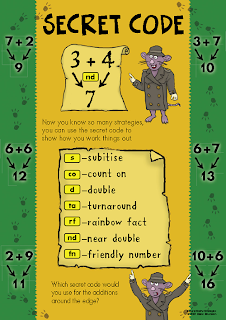Subitizing Leads to Fluency with Addition
Subitize means to suddenly know, in this case to suddenly
know how many.
Going through my stash of cheap wrapping papers (yes I am
addicted to them) I came across a sheet of bright crocodiles. Subitizing came
into my head and with the aid of the wrapping paper, scissors and a glue stick
I suddenly had 14 subitizing cards.
Why is subitizing so important?
Even very young children can look at a small collection and
just know without counting how many are there. In fact if you watch them they
will see 3 crocodiles for instance and put 3 fingers up to match. No visible
counting has taken place.
When children are facile with just visually perceiving they
begin to conceptualise. For the example below for instance it is likely that
students will spot the 2 and the 2 which is instantly known as 4 and 1 more
makes 5.
If you ask what they saw and what they did, this is a likely
explanation. There is a lot embedded in this simple addition:
- It is the first indication that the concept of altogether is developing. Children who touch and count them all will not be demonstrating the concept of altogether in quite this way).
- It is an indication that children are looking for familiar patterns that help them ‘save brain space’.
- It is the beginning of automaticity with number facts and children who have heard terms such as double and count on will be applying those labels and strategies. The Mental Computation books and Natural Maths Strategies for Parents give more detail about this.
The poster that I made for 11 shows that more sophistication
can be brought to the task as visual pattern spotting and number sense further
develop. For this example for instance, students may spot 5 and 5 is 10 and one
more is 11. Alternatively they may spots 6 and 5 as a near double or 7 plus 3
is the rainbow fact that makes to 10 and 1 more is 11. The beauty of these
laminated cards is that students can use markers to make their thinking
visible.
But wait there is more!
At the next level combine two cards and ask students to explain
what they see and how they work out how many on a pair of cards or more.
Encourage comparison of strategies in terms of ease of use, reliability (spotting
10s is usually the most efficient and the most reliable so focus on this at some
points). Combining cards will allow students to use the full range of addition
strategies, count on, double, rainbow facts, near doubles, friendly numbers and
bridge through ten as shown on the poster below.
Digital Technology
Yes once the cards are made they can be captured for the
same use but digitally. And you can make them into a subitizing slideshow in
PowerPoint. Johnny has put together a simple slideshow that you can edit to fit
the wrapping paper of your choice. Click Download PowerPoint file to fetch the How many crocodiles? file and follow
these simple instructions.
- In slide 2, right click the picture and choose Change Picture. This lets you put your own picture into the slide show and the animation effects will still work.
- To change the length of time that the picture stays on the screen, open the Animations tab and click the Animation Pane button in the Advanced Animations section. This will show you the animation steps that are attached to this slide.
- Click on the second action, which is the one that hides the picture. Open the drop-down menu and choose Timing … which opens a dialogue box (see below). Adjust the Delay timing up or down, depending on how long you want the picture to stay on the screen.
- Change the pictures on the remaining screens to your own pictures.
- If you want new slides with the same animation effects,
simply press Ctrl
+ D to duplicate the current slide and all the animation effects will be there on your new slide.
Have Fun!!!






No comments:
Post a Comment